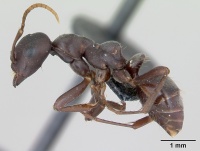Polyergus nigerrimus
| Polyergus nigerrimus | |
|---|---|

| |
| Conservation status | |
| Scientific classification | |
| Kingdom: | Animalia |
| Phylum: | Arthropoda |
| Class: | Insecta |
| Order: | Hymenoptera |
| Family: | Formicidae |
| Subfamily: | Formicinae |
| Tribe: | Formicini |
| Genus: | Polyergus |
| Species group: | samurai |
| Species: | P. nigerrimus |
| Binomial name | |
| Polyergus nigerrimus Marikovsky, 1963 | |
A wide ranging northeastern Paleartic Polyergus species.
| At a Glance | • Dulotic |
Identification
Trager (2013): This species might be confused only with Polyergus samurai, a more eastern, larger, more gracile, and more matte species. Polyergus samurai is more brown than black, and has more yellowish, rather than brown pilosity. Gynes and males of nigerrimus are black, somewhat shiny, smaller than gynes and males of samurai, with dark brown appendages; wings of both gynes and males have brown veins, and are medially infuscated (wings of samurai pale yellow to whitish throughout, with pale veins).
In Trager's (2013) study, 7 W, 1 Q, 1 M from Marikovsky’s original collection, and images of workers from Mongolia (at www.antbase.net), were seen. The former were in the private collection of Alfred Buschinger, and are now housed at CAS. Little notable variation was observed in this small series. The characteristics of this species as described by Kupyanskaya (1990) from a wider geographic area confirm the impression of relative uniformity in metric and ecological characteristics. However, Kupyanksaya’s drawing of a nigerrimus worker shows abundant pilosity arising from the malar region, quite unlike the pilosity pattern of any Polyergus specimens I have studied, and the significance of this is not clear.
Keys including this Species
Distribution
This ant is found in the shrub steppe lands of Mongolia and adjacent southern Russian Federation, and also might be sought in ecologically similar adjacent parts of northwestern China and perhaps Kazakhstan.
Latitudinal Distribution Pattern
Latitudinal Range: 47.16666667° to 47.16666667°.
| North Temperate |
North Subtropical |
Tropical | South Subtropical |
South Temperate |
- Source: AntMaps
Distribution based on Regional Taxon Lists
Palaearctic Region: Mongolia, Russian Federation (type locality).
Distribution based on AntMaps
Distribution based on AntWeb specimens
Check data from AntWeb
Countries Occupied
| Number of countries occupied by this species based on AntWiki Regional Taxon Lists. In general, fewer countries occupied indicates a narrower range, while more countries indicates a more widespread species. |

|
Estimated Abundance
| Relative abundance based on number of AntMaps records per species (this species within the purple bar). Fewer records (to the left) indicates a less abundant/encountered species while more records (to the right) indicates more abundant/encountered species. |

|
Biology
Marikovsky studied P. nigerrimus in the summer of 1960. In his description, Marikovsky (1963) noted that the specimens were taken with abundant host workers of Formica candida (Trager, 2013; de la Mora et al., 2021) in shrub steppe near the Yenisei River. Marikovsky reported a diffuse nest, with 7 entrances over a 10m2 area, but only the central one had a well developed infrastructure and large population, including alates of both sexes, and an ergatoid. He described a raid involving about 400 nigerrimus workers, in the “evening when the sun was setting down” and ending during “falling darkness”. Despite attempts by the F. candida to bite the raiders and to wrest their pupal quarry from them, the nigerrimus simply pushed on home without attacking any of the defending Formica workers. Returning nigerrimus workers initially placed the stolen pupae in two of the peripheral nests, but later transferred the pupae to the main nest about 0.5m away.
Trager (2013) updated the identification of the host with Marikovsy’s sample as F. candida, using Seifert’s (2004) key. Marikovsky had identified them as F. gagates, and Kupyanska (1990) mentions F. picea as the host, also a species previously confused with F. candida. Kupyanskaya calls this an ant of the steppe, and Antonov (2008) also reports habitat of this ant as the steppe. Its host, by implication, in the Antonov study is F. candida (the only abundant potential host at the location). Antonov comments that nigerrimus “is extremely rare in natural habitats,” but this may be an artifact of collecting intensity. The Formica kozlovi host record is from a collection made by Martin Pfeiffer in Mongolia (also note Pfeiffer’s images of nigerrimus at http://antbase.net/htdocs/formicinae/polyergus/polyergus_nigerrimus_marikovsky,_1963.html). Dubatalov (1998) also reports this ant from Mongolia.
Castes
Worker
Images from AntWeb
   
| |
| Nidotype of Polyergus nigerrimus. Worker. Specimen code casent0173329. Photographer April Nobile, uploaded by California Academy of Sciences. | Owned by CAS, San Francisco, CA, USA. |
   
| |
| Nidotype of Polyergus nigerrimus. Worker. Specimen code casent0173331. Photographer April Nobile, uploaded by California Academy of Sciences. | Owned by CAS, San Francisco, CA, USA. |
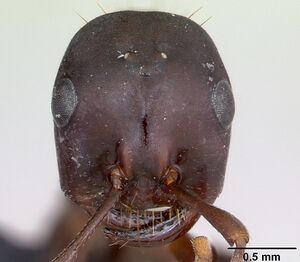   
| |
| Nidotype of Polyergus nigerrimus. Worker. Specimen code casent0173333. Photographer April Nobile, uploaded by California Academy of Sciences. | Owned by CAS, San Francisco, CA, USA. |
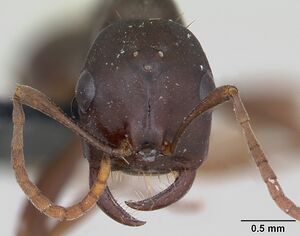   
| |
| Nidotype of Polyergus nigerrimus. Worker. Specimen code casent0173335. Photographer April Nobile, uploaded by California Academy of Sciences. | Owned by CAS, San Francisco, CA, USA. |
   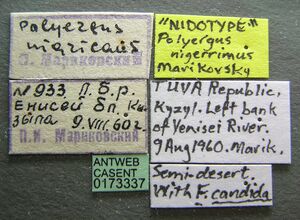
| |
| Nidotype of Polyergus nigerrimus. Worker. Specimen code casent0173337. Photographer April Nobile, uploaded by California Academy of Sciences. | Owned by CAS, San Francisco, CA, USA. |
  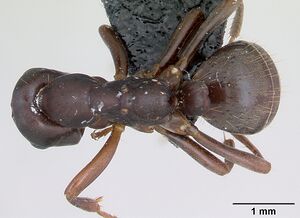 
| |
| Nidotype of Polyergus nigerrimus. Worker. Specimen code casent0173338. Photographer April Nobile, uploaded by California Academy of Sciences. | Owned by CAS, San Francisco, CA, USA. |
Queen
Images from AntWeb
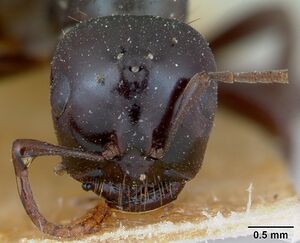     
| |
| Nidotype of Polyergus nigerrimus. Queen (alate/dealate). Specimen code casent0173340. Photographer April Nobile, uploaded by California Academy of Sciences. | Owned by CAS, San Francisco, CA, USA. |
Male
Images from AntWeb
   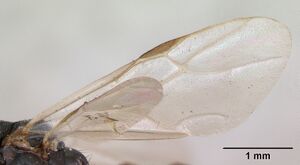   
| |
| Nidotype of Polyergus nigerrimus. Male (alate). Specimen code casent0173339. Photographer April Nobile, uploaded by California Academy of Sciences. | Owned by CAS, San Francisco, CA, USA. |
Nomenclature
The following information is derived from Barry Bolton's Online Catalogue of the Ants of the World.
- nigerrimus. Polyergus nigerrimus Marikovsky, 1963: 110, figs. 1-7 (w.q.m.) RUSSIA. See also: Kupyanskaya, 1990: 208.
Unless otherwise noted the text for the remainder of this section is reported from the publication that includes the original description.
Type Material
- Syntype, worker, queen, male, Kyzyl, Tuva, Russian Federation, 51°43′0″N 94°27′0″E / 51.716667°N 94.45°E, Zoological Institute, Russian Academy of Sciences, St. Petersburg.
- Syntype, 7 workers, queen, male, Kyzyl, Tuva, Russian Federation, 51°43′0″N 94°27′0″E / 51.716667°N 94.45°E, California Academy of Sciences; (type nest series, examined by Trager (2013)).
Description
Worker
Trager (2013) - Syntypes (N=7) HL 1.32–1.44 (1.40), HW 1.24–1.36 (1.32), SL 1.00–1.06 (1.03), ½ VeM 1–9 (4.71), ½ PnM 5–7 (6.29), WL 2.12–2.20 (2.17), GL 1.76–2.00 (1.93), HFL 1.60–1.68 (1.64), CI 94–96 (94.4), SI 74–81 (79), HFI 119–130 (125), FSI 157–160 (159), LI 3.48–3.60 (3.56), TL 5.24–5.60 (5.49).
Smallish, TL averaging 5.5mm; blackish, weakly shining species of the Asian steppes. Head rounded hexagonal (truncate-ovate), its length detectably greater than breadth; with conspicuous vertex pilosity; scapes not reaching vertex, notably clavate in the apical third; pronotum with 10–14 dorsal erect setae; mesonotum with profile flat or very weakly convex for most of its length, with a short posterior declivity; propodeal profile subquadrate, taller than pronotum, with concave declivity profile; petiole with sides round, converging dorsad, petiolar dorsum emarginate; first tergite densely pubescent, with pilosity in 3 or 4 irregular transverse rows, first tergite pilosity gently curved, longer than the distance separating the individual setae.
Head weakly shining; mesonotum weakly shining dorsally, a bit smoother laterally; gaster weakly shining to matte dorsally, somewhat shiny laterally.
Color black to nearly black; legs and scapes dark brown; pilosity gray-brown.
Etymology
Trager (2013) - This name is from the Latin superlative adjective “nigerrimus”, meaning very black or blackest. A hand written label accompanying the series reads “nigricans”, meaning blackish, but this name never reached publication.
References
- Cantone S. 2017. Winged Ants, The Male, Dichotomous key to genera of winged male ants in the World, Behavioral ecology of mating flight (self-published).
- Cantone S. 2018. Winged Ants, The queen. Dichotomous key to genera of winged female ants in the World. The Wings of Ants: morphological and systematic relationships (self-published).
- Castracani, C., Tamarri, V., Grasso, D.A., Le Moli, F., Palla, G., Millar, J.G., Francke, W., Mori, A. 2008. Chemical communication in mating behaviour of the slave-making ant Polyergus rufescens (Hymenoptera, Formicidae): 3-ethyl-4-methylpentanol as a critical component of the queen sex pheromone. Insectes Sociaux 55, 137–143 (doi:10.1007/s00040-008-0981-x).
- de la Mora, A., Sankovitz, M., Purcell, J. 2020. Ants (Hymenoptera: Formicidae) as host and intruder: recent advances and future directions in the study of exploitative strategies. Myrmecological News 30: 53-71 (doi:10.25849/MYRMECOL.NEWS_030:053).
- D'Ettorre, P., Heinze, J. 2001. Sociobiology of slave-making ants. Acta ethologica 3, 67–82 (doi:10.1007/s102110100038).
- Dubovikoff, D.A., Yusupov, Z.M. 2017. Family Formicidae - Ants. In Belokobylskij S. A. and A. S. Lelej: Annotated catalogue of the Hymenoptera of Russia. Proceedingss of the Zoological Institute of the Russian Academy of Sciences 6: 197-210.
- Kupyanskaya, A. N. 1990a. Ants of the Far Eastern USSR. Vladivostok: Akademiya Nauk SSSR, 258 pp. (page 208, see also)
- Marikovsky, P. I. 1963a. A new species of ant Polyergus nigerrimus Marik., sp. n. (Hymenoptera, Formicidae) and some features of its biology. Entomol. Obozr. 42: 110-114 (page 110, figs. 1-7 worker, queen, male described)
- Marikovsky, P. I. 1963b. A new ant, Polyergus nigerrimus Marik., sp. n., (Hymenoptera, Formicidae) and some features of its biology. Entomol. Rev. (Wash.) 42: 58-59 (page 58, worker, queen, male described)
- Trager, J.C. 2013. Global revision of the dulotic ant genus Polyergus (Hymenoptera: Formicidae, Formicinae, Formicini). Zootaxa 3722, 501–548.
References based on Global Ant Biodiversity Informatics
- Antonov I. A. 2013. Ant Assemblages (Hymenoptera: Formicidae) of Cities of the Temperate Zone of Eurasia. Russian Journal of Ecology 44(6): 523526.
- Dubovikoff D. A., and Z. M. Yusupov. 2018. Family Formicidae - Ants. In Belokobylskij S. A. and A. S. Lelej: Annotated catalogue of the Hymenoptera of Russia. Proceedingss of the Zoological Institute of the Russian Academy of Sciences 6: 197-210.
- Lelej A. S. 2012. Annotated catalogue of the Insects of Russian Far East. Volume 1. Hymenoptera. Dalnauka: Vladivostok. 635 p.
- Marikovsky P. I. 1963. A new ant, Polyergus nigerrimus Marik., sp. n., (Hymenoptera, Formicidae) and some features of its biology. Entomol. Rev. (Wash.) 42: 58-59.
- Trager J. C. 2013. Global revision of the dulotic ant genus Polyergus (Hymenoptera: Formicidae, Formicinae, Formicini). Zootaxa 3722(4): 501-548.
- Pages using DynamicPageList3 parser function
- IUCN Red List vulnerable species
- Dulotic
- North temperate
- Ant Associate
- Host of Formica candida
- Host of Formica kozlovi
- Species
- Extant species
- Formicidae
- Formicinae
- Formicini
- Polyergus
- Polyergus nigerrimus
- Formicinae species
- Formicini species
- Polyergus species
- Need Overview
- Need Body Text
- IUCN Red List
- Ssr

